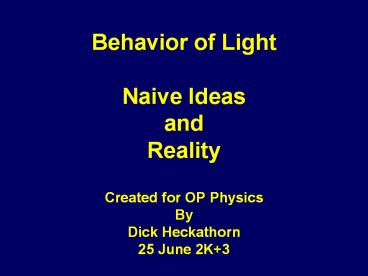Behavior%20of%20Light%20Naive%20Ideas%20and%20Reality - PowerPoint PPT Presentation
Title:
Behavior%20of%20Light%20Naive%20Ideas%20and%20Reality
Description:
Behavior of Light Naive Ideas and Reality Created for OP Physics By Dick Heckathorn 25 June 2K+3 Idea 1 Plane Mirror A mirror reverses everything. Idea 2 Plane Mirror ... – PowerPoint PPT presentation
Number of Views:130
Avg rating:3.0/5.0
Title: Behavior%20of%20Light%20Naive%20Ideas%20and%20Reality
1
Behavior of LightNaive IdeasandReality
- Created for OP Physics
- By
- Dick Heckathorn
- 25 June 2K3
2
Idea 1 Plane Mirror
- A mirror reverses everything.
Reality 1 Plane Mirror
There is no reversal in a mirror!
3
Idea 2 Plane Mirror
- An observer can see more of their mirror image by
moving further back from the mirror.
Reality 2 Plane Mirror
The amount of yourself that you can see in the
mirror does not depend on your distance from the
mirror.
4
Idea 3 Plane Mirror
- The mirror image of an object is located on the
surface of the mirror. - The image is often thought of as a picture on a
flat surface.
5
Reality 3 Plane Mirror
- The image of an object seen in a plane mirror is
located as far behind the mirror as the object is
in front of the mirror. - Further, a line drawn from an object point to its
image point is perpendicular to the mirror
surface.
6
Idea 4a Plane Mirror
- The way a mirror works is as follows the image
first goes from the object to the mirror surface, - then the observer either sees the image on the
mirror surface or the image reflects off the
mirror and goes into the observer's eye.
7
Idea 4b Plane Mirror
- Light reflects from a shiny surface in an
arbitrary manner.
8
Reality 4 Plane Mirror
- When light reflects from a mirror,
- the angle of incidence
- equals
- the angle of reflection
- (This is the law of reflection.)
9
Idea 5 Light Reflection
- Light is reflected from smooth mirror surfaces
but not from non-shiny surfaces.
Reality 5 Light Reflection
Light is reflected from both shiny and non-shiny
surfaces.
10
Idea 6 Curved Mirrors
- Curved mirrors make everything distorted.
Reality 6 Curved Mirrors
Curved mirrors give clear images. The images can
be larger, smaller right-side-up or up-side-down.
11
Idea 7 Speed of Light
- The effects of light are instantaneous. Light
does not travel with a finite speed.
Reality 7 Speed of Light
Light does travel with finite speed even though
it is very fast.
12
Idea 8 Traveling Light
- Light shines on a transparent material and
illuminates it so that it can be seen. Light does
not travel from the material to the eye.
Light can travel through some materials as it
travels from the illuminated object or light
source to your eye.
13
Idea 9 Light Refraction
- Light always passes through a transparent
material without changing directions.
Reality 9 Light Refraction
Light does change direction when it goes from one
medium to another.
14
Idea 10 Light Refraction
- When an object is viewed through a transparent
solid or liquid material, the object is seen
exactly where it is located.
When looking at an object through a transparent
material, the object will either look distorted
or will be seen at a different place than it
actually is.
15
Idea 12 Image
- The purpose of the screen is to capture the image
so it can be seen. The screen is necessary for
the image to be seen. Without a screen there is
no image.
Reality 12 Image
The screen only helps us to see the image.
16
Idea 14a Image
- Blocking part of the lens surface would block the
corresponding part of the image.
Reality 14a Image
Blocking part of the lens only makes the image
dimmer.
17
Idea 14b Image
- An image produced by a lens can be seen on a
screen located in any position.
Reality 14b Image
For an image to be seen on the screen, the screen
must be placed at a specific place.
18
Idea 14c Image
- Moving a screen further away from the lens will
cause the image to be larger.
Reality 14c Image
Moving the screen further away does not make for
a larger, clear image on the screen.
19
Idea 15 Image
- The image is always formed at the focal point of
the lens.
20
Reality 15 Image
- For a given distance between the object and the
lens, there is a single image position for the
screen where the image is the sharpest. - Moving the screen from that point will cause the
image to first blur and then vanish.
21
Thats All Folks































